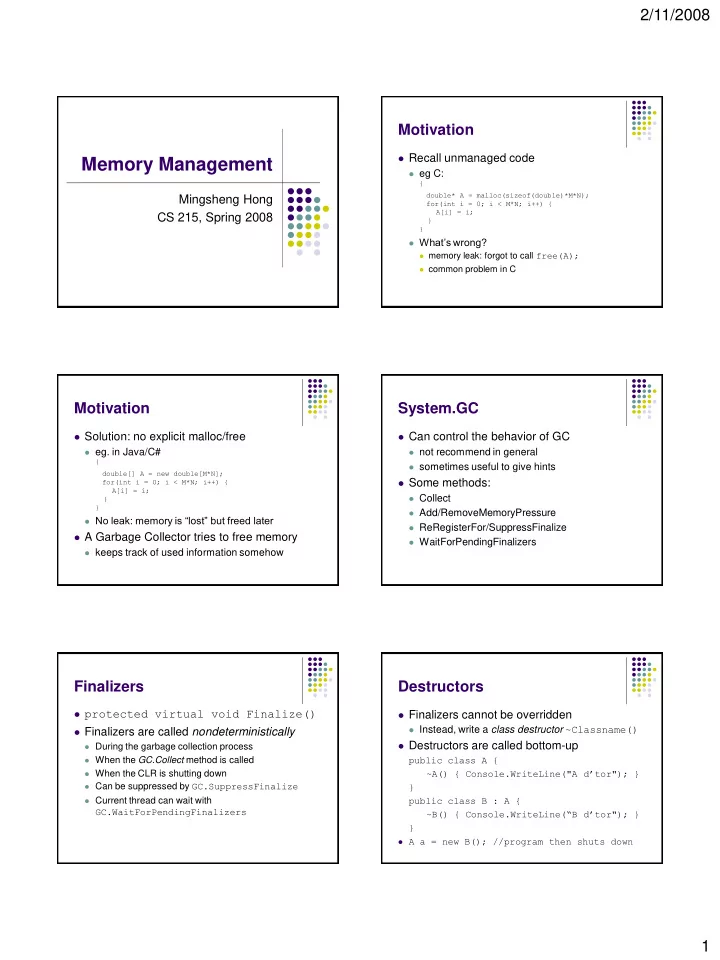

2/11/2008 Motivation Recall unmanaged code Memory Management eg C: { double* A = malloc(sizeof(double)*M*N); Mingsheng Hong for(int i = 0; i < M*N; i++) { A[i] = i; CS 215, Spring 2008 } } What’s wrong? memory leak: forgot to call free(A); common problem in C Motivation System.GC Solution: no explicit malloc/free Can control the behavior of GC eg. in Java/C# not recommend in general { sometimes useful to give hints double[] A = new double[M*N]; for(int i = 0; i < M*N; i++) { Some methods: A[i] = i; Collect } } Add/RemoveMemoryPressure No leak: memory is “lost” but freed later ReRegisterFor/SuppressFinalize A Garbage Collector tries to free memory WaitForPendingFinalizers keeps track of used information somehow Finalizers Destructors protected virtual void Finalize() Finalizers cannot be overridden Instead, write a class destructor ~Classname() Finalizers are called nondeterministically Destructors are called bottom-up During the garbage collection process When the GC.Collect method is called public class A { ~A() { Console.WriteLine("A d’tor"); } When the CLR is shutting down Can be suppressed by GC.SuppressFinalize } public class B : A { Current thread can wait with GC.WaitForPendingFinalizers ~B() { Console.WriteLine(“B d’tor"); } } A a = new B(); //program then shuts down 1
2/11/2008 Finalizers are Expensive IDisposable IDispose declares void Dispose() Finalization in GC: When object with Finalize method created Can be explicitly invoked public class A: IDisposable { add to Finalization Queue public A() { // Allocate resources } First GC: moved to Freachable queue public void Dispose() { // Release resources } After finalizer is called, memory released in a } future GC A disposableobject=null; try { disposableobject=new A(); } One single thread to call finalizers finally { At least 2 GC cycles needed disposableobject.Dispose(); disposableobject=null; } The using Statement Weak References using calls Dispose automatically Sometimes want to keep references but not cause the GC to wait using(A disposableobject= new A()) { A a = new A(); // use object WeakReference wr = new WeakReference(a); } Now a can be collected Can declare multiple objects wr.Target is null if referenced after a collected using(A a1 = new A(), a2 = new A()) Usage using(B b1 = new B()) { Large objects infrequently accessed // use objects nice to have but can be regenerated } Handles to strings in a string table Object Pinning Soundness and Completeness Can require that an object not move For any program analysis could hurt GC performance Sound? useful for unsafe operation are the operations always correct? usually an absolute requirement in fact, needed to make pointers work Complete? syntax: does the analysis capture all possible instances? fixed(…) { … } For Garbage Collection will not move objects in the declaration in the sound = does it ever delete current memory? block complete = does it delete all unused memory? 2
2/11/2008 Reference Counting Reference Counting Keep count of references Disadvantages on assignment, increment (and decrement) can’t detect cycles when removing variables, decrement constant cost, even when lots of space eg. local variables being removed from stack optimize the common case! at ref count 0, reclaim object space Advantage: incremental (don’t stop) Is this safe? 2 1 Yes: not reference means not reachable 1 1 Reachable Reachability Graph Reachability Graph Instead of counting references Top-level objects (roots) keep track of some top-level objects managed by CLR and trace out the reachable objects local variables on stack only clean up heap when out of space registers pointing to objects much better for low-memory programs Garbage collector starts top-level Two major types of algorithm builds a graph of the reachable objects Mark and Sweep Copy Collectors Mark and Sweep Copy Collectors Instead of just marking as we trace Two-pass algorithm First pass: walk the graph and mark all objects copy each reachable object to new part of heap everything starts unmarked needs to have enough space to do this Second pass: sweep the heap, remove unmarked no need for second pass not reachable implies garbage Advantages Soundness? one pass Yes: any object not marked is not reachable compaction Completeness? Disadvantages Yes, since any object unreachable is not marked higher memory requirements But only complete eventually 3
2/11/2008 Compacting Copy Collector Compacting Copy Collector Move live objects to bottom of heap Another possible collector: leaves more free space on top divide memory into two halves contiguous allocation allows faster access fill up one half before doing any collection cache works better with locality on full: Must then modify references walk the graph and copy to other side work from new side recall: references are really pointers Need twice memory of other collectors must update location in each object But don’t need to find space in old side contiguous allocation is easy Fragmentation Heap Allocation Algorithms best-fit Common problem in memory schemes search the heap for the closest fit Enough memory but not enough contiguous takes time consider allocator in OS causes external fragmentation (as we saw) first-fit choose the first fit found 10 10? starts from beginning of heap 10 5 next-fit first-fit with a pointer to last place searched 15 10 5 C# Memory management Generations Current .NET uses 3 generations: Related to next-fit, copy-collector 0 – recently created objects: yet to survive GC keep a NextObjPointer to next free space 1 – survived 1 GC pass use it for new objects until no more space 2 – survived more than 1 GC pass Keep knowledge of Root objects During compaction, promote generations global and static object pointers eg. Gen 1 reachable object goes to Gen 2 all thread stack local variables Assumption: longer lived implies live longer registers pointing to objects Valid for many applications maintained by JIT compiler and runtime eg. JIT keeps a table of roots 4
2/11/2008 C# Garbage Collectors Workstation GC Concurrent GC Non-concurrent GC Server GC Optimize for throughput, not response time 5
Recommend
More recommend